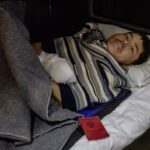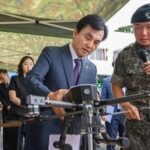With Only 20 Elite Agents, Air Force Combat Control Team (CCT), ‘Red Berets’ – Part 1
Daniel Kim Views
![단 20명 밖에 없는 ‘특수부대 중 특수부대’…‘붉은 베레모’ 공정통제사(CCT)[이현호 기자의 밀리터리!톡]](https://contents-cdn.viewus.co.kr/image/2024/03/CP-2023-0094/image-76f5d78a-c854-466b-90b0-b0500eb9e2e7.jpeg)
On March 13, the ROKAF Air Mobility & Reconnaissance Command conducted an Allied ATSP (Air Terminal Supply Point) Establishment and Takeoff/Landing Training as part of the Freedom Shield (FS) joint exercise at the Namji emergency Airfield in Changnyeong-gun, Gyeongnam. Our Air Force’s C-130 and CN-235 transport aircraft, CH-47 helicopters, and US Air Force’s A-10 attack aircraft participated in the training.
The Air Force needs the ability to establish an ATSP quickly. Whether aircraft can take off, land, and load and unload cargo in even the most unfamiliar places during wartime can determine the war’s outcome. This training is a practice to familiarize the Korean and US Air Forces with the procedures of training the establishment of an “Air Terminal Supply Point (ATSP)” and takeoff and landing to execute air supply operations under any circumstances perfectly.
Combat Control Team (CCT) members from both countries, who will carry out the most important missions to enhance the operational capabilities of the joint forces, also participated in this training. The ATSP is an airfield built and operated to provide smooth air supply to areas where ground supply is complex during wartime. It plays a critical role in enhancing the combat sustainability of allied forces on the front lines.
The training begins with “airfield evaluation.” The base evaluation team composed of CCT assesses the damage to major operational facilities such as runways and their usability, the unit’s boundaries, safety, and the condition of the airfield, and determines the possibility of establishing and operating an ATSP.
Building an Air Supply Base at the Front Line of War
First, the base evaluation team deploys to the Namji emergency runway, which is assumed to be the location for establishing the ATSP, by riding a CH-47 helicopter. They then closely examine the possibility of establishing the base, such as the operability of base operational facilities and the minimum standards for runway operations. Once it is determined that the ATSP can be established and operated, the members of the base evaluation team move by riding a C-130.
After arriving at the site, they quickly installed the facilities and equipment necessary for ATSP operation. In this process, the CCT members cleaned up even small stones on the runway and checked the weather, wind speed, and wind direction. Once the ATSP was established, they immediately performed supply base support missions for the Allied forces.
Then, the ATSP takeoff and landing training is conducted. When our Air Force’s transport aircraft carrying supplies and the US Air Force’s A-10 attack aircraft appear in the air, the aircraft land on the runway in order according to the control of the Korean and US CCTs. The landed transport aircraft conduct airdrop cargo loading and unloading training, and the aircraft that have completed airdrop cargo loading, unloading, takeoff, and landing training take off towards the mother base under the guidance of the Korean and US CCTs, which is the end of the training.
![단 20명 밖에 없는 ‘특수부대 중 특수부대’…‘붉은 베레모’ 공정통제사(CCT)[이현호 기자의 밀리터리!톡]](https://contents-cdn.viewus.co.kr/image/2024/03/CP-2023-0094/image-2749a9d3-1db2-45f0-baa6-56214fdaadbf.jpeg)
“The first to enter and the last to leave.” This is the motto of the Combat Control Team (CCT), considered the elite special forces of the Air Force. The Air Force’s Combat Control Team (CCT) is a special mission unit under the 259th Special Mission Battalion under the 5th Air Mobility Flight Wing of the Air Force Air Mobility Reconnaissance Command, a functional command under the Air Force Operations Command.
The CCT informs allied transport aircraft of weather, wind direction, and wind speed and controls altitude and azimuth when the transport aircraft enters the target location to safely reach the desired location. In simple terms, they are quickly deployed to control facilities in enemy territories where control facilities are not adequately equipped and when the enemy’s airport is captured by allied forces, with no civilian controllers immediately available.
Must Pass Over 3 Years of Rigorous Training to be Deployed in Operations
The Air Force Combat Control Team was established in April 1978 as a platoon-scale unit under the 5th Tactical Airlift Wing by the Korea Air Force, which felt the need for it through the US Air Force CCT, which played an active role in the Vietnam War. It is also referred to as the 784 Unit as it was established in April 1978, 10 years after the Air Force’s special unit, the 684 Unit, which was created in April 1968, was disbanded.
On July 1, 2020, when the 259th Tactical Airlift Support Battalion was converted and established as the 259th Special Mission Battalion, the Combat Control Company, a subordinate unit, was also expanded and reorganized into a special mission company.
In the past, they were selected from among air traffic control specialty non-commissioned officer candidates, but from the 224th generation in 2015, they were chosen through a special selection process. Once selected as a member of CCT, they undergo 12 weeks of basic military training for Air Force non-commissioned officer candidates. They are commissioned and receive 16 weeks of air traffic control education.
They can only become CCTs after completing one year of in-house education and two years of commissioned education from the Army, Navy special forces, and Marine Corps. They must undergo about three years of training, including Air Force survival and mountain terrain overcoming training, land navigation training, as well as the Army Special Forces’ Airborne Basic, Jumpmaster (J/M), Parachute Maintenance, High Altitude Basic, Rigger, Combat Diver, Mountain Specialist (RANGER), Counter-Terrorism Training (CT), and Navy Special Warfare Unit’s UDT/SEAL Special Warfare Beginner’s Training, to be selected as a member.















Most Commented